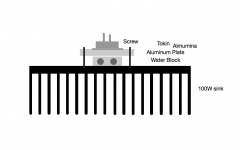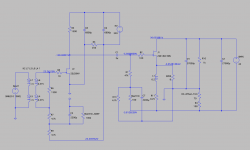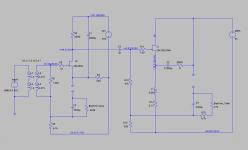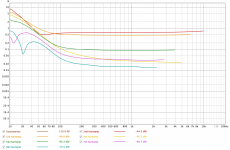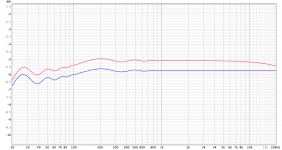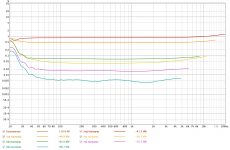s610adam, I got Diana 1.54.12 from Edmond, so now I can check the phase of distortion. Let's see. I'm also thinking to get a water cooler (kind of seriously). My idea is putting radiator inside in winter and outside in summer, but I still have too many questions about it, something like pump, water hose length limitation, etc. etc... Do you have any knowledge about it?
Nice! I've got an M-audio card that I haven't used yet, but going to look into RMAA and Diana.
Here's the parts I'm about to experiment with, I'll report back on how it goes and a more detailed list and temperatures. But in short, here's some thoughts on the 4 main components: Pump, Radiator (& fans), reservoir, and the actual cooling block.
I'm sort of prioritizing redundancy and over-sizing with the list too (since this is DIY!), and because even these 500W 32 core processors aren't running continuous duty (and have thermal-throttling if they do creep up). The heat capacity of water is nice for absorbing the 500W power spikes, but for Class A, we're looking at overall radiator area being most important, whether it's connected to the FET through water cooling, or standard PC cooler copper heat pipes, or fans on a standard heatsink. Also, I guess that not having the outdoor radiator in direct sunlight will also be important.
Radiator: You can buy in multiples of 120mm lengths (standard PC fan sizes). Some of the 32 core chips out there are doing ok on 240mm, with 360mm bringing temps down another 10C. These Swiftech folks in CA have some well designed options, with a built in reservoir as well:
Swiftech MCRX20-QP-RADIATOR SERIES - PC Liquid Cooling Systems CPU Cooler VGA Water Block Heatsink Pump Radiator Heat Exchanger Kit
Cooling Block: This block is 40mm wide and might just allow the bolt pattern on the 2SK182 to fit around the block, I'll find out.
Amazon.com: DIYhz Aluminum Water Cooling Block, Liquid Water Cooler Heat Sink System for PC Computer CPU Graphics Radiator Heatsink Endothermic Head Silver 2pcs(40mm x 80mm x 12mm): Computers & Accessories
It's sold in many lengths, and if I was trying to balance a push-pull DC coupled design like the CSX1 (which I am 🙂 ), I'd have all the Fets of one channel on one block. But for SE designs, two shorter cold-blocks in series will still still keep them around the same temperature, and allow another possible redundancy, mounting a standard PC-cooling fan on the other side of the block. This way, even if the liquid cooling system is off, there could be a heatsink & maybe fan. It's what could run in the winter, too. I'm planning to run RV antifreeze in the loop, but may still have quick-disconnects for winter.
Pump: Swiftech again, and actually listing mean-time-between-failures as a design criteria is nice. They take 12v, can don't need the PWM controller to limit RPM if you run them at maximum. There's a bunch of PC speed controllers out there though. And fancy LED light controllers too.
I'm thinking about putting two pumps in series, the flow rates will be ~additive, and redundant if one fails. I'll start with one pump though, this was more an idea for the cheaper pumps out there. As far as hose lengths, the most restrictive component will generally limit flow rate for the loop, and so I think long hose runs are OK to the outside. Thoughts would be on purging the bubbles out initially, at the highest location (reservoir).
Pumps, with the "D5" model being very common for PC's: MCP Pumps - Swiftech
Pump with reservoir: Maelstrom D5 V2 Series - Rouchon Industries Inc., dba Swiftech - PC Liquid Cooling Systems CPU Cooler VGA Water Block Heatsink Pump Radiator Heat Exchanger Kit
G1/4 threaded ports this is the common thread designation, with various costs and qualities of barb or compression fittings to the hose.
Lastly, a simple way to go is what they call "all in one" coolers. Most have the pump attached to the coldplate, and my EMI-phobia speaks up with mounting the 12v pump near the FET. Don't know if it's justified, but the input transformer might pick some up too. This one doesn't have that issue, pump and reservoir is part of the radiator. Nice and compact too, just switch the CPU cooler with that Amazon coldplate:
Swiftech Drive X3 AIO CPU Coolers
Here's the parts I'm about to experiment with, I'll report back on how it goes and a more detailed list and temperatures. But in short, here's some thoughts on the 4 main components: Pump, Radiator (& fans), reservoir, and the actual cooling block.
I'm sort of prioritizing redundancy and over-sizing with the list too (since this is DIY!), and because even these 500W 32 core processors aren't running continuous duty (and have thermal-throttling if they do creep up). The heat capacity of water is nice for absorbing the 500W power spikes, but for Class A, we're looking at overall radiator area being most important, whether it's connected to the FET through water cooling, or standard PC cooler copper heat pipes, or fans on a standard heatsink. Also, I guess that not having the outdoor radiator in direct sunlight will also be important.
Radiator: You can buy in multiples of 120mm lengths (standard PC fan sizes). Some of the 32 core chips out there are doing ok on 240mm, with 360mm bringing temps down another 10C. These Swiftech folks in CA have some well designed options, with a built in reservoir as well:
Swiftech MCRX20-QP-RADIATOR SERIES - PC Liquid Cooling Systems CPU Cooler VGA Water Block Heatsink Pump Radiator Heat Exchanger Kit
Cooling Block: This block is 40mm wide and might just allow the bolt pattern on the 2SK182 to fit around the block, I'll find out.
Amazon.com: DIYhz Aluminum Water Cooling Block, Liquid Water Cooler Heat Sink System for PC Computer CPU Graphics Radiator Heatsink Endothermic Head Silver 2pcs(40mm x 80mm x 12mm): Computers & Accessories
It's sold in many lengths, and if I was trying to balance a push-pull DC coupled design like the CSX1 (which I am 🙂 ), I'd have all the Fets of one channel on one block. But for SE designs, two shorter cold-blocks in series will still still keep them around the same temperature, and allow another possible redundancy, mounting a standard PC-cooling fan on the other side of the block. This way, even if the liquid cooling system is off, there could be a heatsink & maybe fan. It's what could run in the winter, too. I'm planning to run RV antifreeze in the loop, but may still have quick-disconnects for winter.
Pump: Swiftech again, and actually listing mean-time-between-failures as a design criteria is nice. They take 12v, can don't need the PWM controller to limit RPM if you run them at maximum. There's a bunch of PC speed controllers out there though. And fancy LED light controllers too.
I'm thinking about putting two pumps in series, the flow rates will be ~additive, and redundant if one fails. I'll start with one pump though, this was more an idea for the cheaper pumps out there. As far as hose lengths, the most restrictive component will generally limit flow rate for the loop, and so I think long hose runs are OK to the outside. Thoughts would be on purging the bubbles out initially, at the highest location (reservoir).
Pumps, with the "D5" model being very common for PC's: MCP Pumps - Swiftech
Pump with reservoir: Maelstrom D5 V2 Series - Rouchon Industries Inc., dba Swiftech - PC Liquid Cooling Systems CPU Cooler VGA Water Block Heatsink Pump Radiator Heat Exchanger Kit
G1/4 threaded ports this is the common thread designation, with various costs and qualities of barb or compression fittings to the hose.
Lastly, a simple way to go is what they call "all in one" coolers. Most have the pump attached to the coldplate, and my EMI-phobia speaks up with mounting the 12v pump near the FET. Don't know if it's justified, but the input transformer might pick some up too. This one doesn't have that issue, pump and reservoir is part of the radiator. Nice and compact too, just switch the CPU cooler with that Amazon coldplate:
Swiftech Drive X3 AIO CPU Coolers
Last edited:
s610adam, that's a tons of information. Many thanks. Class A heat has been my headache for many years, and it's exciting challenging for me. Maybe we should start water cooling thread, then. There are still many questions, but I think I understand the basics now, so that I can research by myself deeper. Keep in touch.
I still own old MAudio interface. MAudio's Price/performance ratio is super.
I still own old MAudio interface. MAudio's Price/performance ratio is super.
No problem, I'll post info if I make successful progress. Mostly, I want it to be worry free, like passive heatsinks basically are.
Great. I'll post mine, too. I have already ordered a few of those Amazon blocks. Thank you for the link. I think I'll connect several short 1/4 tube to long cheap PEX 1/2 tube (Home Depot carry them, $13 for 50feet!). Parallel water distribution for each FET.
Last edited:
This is my idea, what do you think?
Hybrid Air and Water cooling. In winter, heat sink will dissipate more (warmer room), and heat sink can work as a safety device. 🙂
Actually, I canceled Amazon order (40x40), I think I want to have larger water blocks (80x40?), so that water block can also work as a heat spreader.
Hybrid Air and Water cooling. In winter, heat sink will dissipate more (warmer room), and heat sink can work as a safety device. 🙂
Actually, I canceled Amazon order (40x40), I think I want to have larger water blocks (80x40?), so that water block can also work as a heat spreader.
Attachments
Last edited:
Not expert here, but the manifold appears as a thermal resistance to spreading (effectively) to the sink under any scenario. Better to me seems to the have the active device mated to the sink and the alternative cooling as being on the sink as well. Device to sink, liquid taking away from sink. Hot seeking cold, and better for calculating scale of the supplemental liquid cooling in worst case seasonal scenario, if that makes sense. (ie, smallest liquid system needed, making full use of sink too). To maximize that, the manifold would seem to be as far away from the device as possible. But that's just another scenario, perhaps liquid performs so well, the point is moot for the purpose anyway.
Last edited:
res07njc , that's reasonable. Then copper water block would be more suitable for my idea, but I don't know... Well, I need a bit more research for this, indeed.
Amazon.com: Pure Copper Water Cooling Block 40x40mm for Liquid Water Cooler Heat Sink System Silver for CPU Graphics Radiator Heatsink (1 Pack): Computers & Accessories
Amazon.com: Pure Copper Water Cooling Block 40x40mm for Liquid Water Cooler Heat Sink System Silver for CPU Graphics Radiator Heatsink (1 Pack): Computers & Accessories
I did a quick listening test (Amp#1 vs Hypex nCore NC122MP).
If this amp had sounded like nCore, I would have been really disappointed. I agree with Mr. Pass, I also would recommend to get TOKIN if you still don't have any. Even in this simple amp, it sounds just great. I ordered 4 extra 2SK182ES. The price of 2SK182ES has not been changed since last summer, and you're not late to the party. 🙂
A note: Tomoaki Watanabe-san is in Japan, and I was told the shipping is surface, and it should take a few months (No air mail to US is accepted in Japan now).
If this amp had sounded like nCore, I would have been really disappointed. I agree with Mr. Pass, I also would recommend to get TOKIN if you still don't have any. Even in this simple amp, it sounds just great. I ordered 4 extra 2SK182ES. The price of 2SK182ES has not been changed since last summer, and you're not late to the party. 🙂
A note: Tomoaki Watanabe-san is in Japan, and I was told the shipping is surface, and it should take a few months (No air mail to US is accepted in Japan now).
Hi plasnu, I was unsure if you intended to use supplemental cooling full-time, or just some of the time.... in any event i applaud your work here as I have these parts as well (thf at least) and look forward to your success. 🙂
res07njc, thank you for your kind words. I will definitely experiment water cooling for this amp, and I'll keep reporting here.
Yes, my ultimate goal was water cooling full-time in summer, air cooling in winter, but I realized that it should require some kind of variable thermal structure between air and water sink. It seems that variable thermal conductivity material has not invented yet, so only solution would be a mechanical one. My realistically compromised solution would probably be permanently attaching 100 watt or so heatsink to water cooler, and dissipating some in the air, rest in the water all the time. 🙂
Yes, my ultimate goal was water cooling full-time in summer, air cooling in winter, but I realized that it should require some kind of variable thermal structure between air and water sink. It seems that variable thermal conductivity material has not invented yet, so only solution would be a mechanical one. My realistically compromised solution would probably be permanently attaching 100 watt or so heatsink to water cooler, and dissipating some in the air, rest in the water all the time. 🙂
Last edited:
Updated Schematics Amp#1 v.1.1
I've found a rather serious mistake, and it was fixed. If anyone sees something wrong, please let me know.
----------
What's new v1.1:
- Bias scheme of Sony is fixed. A capacitor and 2 resistors added. We have to do something like this to protect the gate from high voltage.
- Bias trimpod for Sony is also added. Not tested, but it should work.
- HV2 is now 320V, and values of several parts have updated.
- R10 and 3 trimpods' values has to be investigated a little more.
- Amp#2 is abandoned, and I don't think I will update it any more.
I've found a rather serious mistake, and it was fixed. If anyone sees something wrong, please let me know.
----------
What's new v1.1:
- Bias scheme of Sony is fixed. A capacitor and 2 resistors added. We have to do something like this to protect the gate from high voltage.
- Bias trimpod for Sony is also added. Not tested, but it should work.
- HV2 is now 320V, and values of several parts have updated.
- R10 and 3 trimpods' values has to be investigated a little more.
- Amp#2 is abandoned, and I don't think I will update it any more.
Attachments
A huge water block and 100ft water pipe arrived today. I think I can start water cooling evaluation this weekend. 🙂
The values of output bias/voltage divider section is now updated, but inrush current remains 3-5 seconds without thermistors. While thermistors in my drawer did a really good job to suppress it, I need to get more variations of different thermistors to keep testing safely.
The values of output bias/voltage divider section is now updated, but inrush current remains 3-5 seconds without thermistors. While thermistors in my drawer did a really good job to suppress it, I need to get more variations of different thermistors to keep testing safely.
Updated v1.2:
I went back to my very first version after some experiments with real amp. While LTSpice shows considerably less distortion with previous versions, I find the real amp actually doesn't show any difference except low frequency THD is just a little different. Many issues are now solved just moving C2 from back to front of the speaker. My limited knowledge could not beat a simple and conventional way, but it was a good experiment for me, and I learned a lot of things. 🙂
Measured w/8ohm load. Sony 95mA, Tokin 4.2A.
FR/THD @1W
FR/THD @50W
FR @1W-Blue, @50W-Red (showing better slew rate)
I'll increase choke and input transformer size and start listening test. (I've got all the water cooling parts. 🙂)
I went back to my very first version after some experiments with real amp. While LTSpice shows considerably less distortion with previous versions, I find the real amp actually doesn't show any difference except low frequency THD is just a little different. Many issues are now solved just moving C2 from back to front of the speaker. My limited knowledge could not beat a simple and conventional way, but it was a good experiment for me, and I learned a lot of things. 🙂
Measured w/8ohm load. Sony 95mA, Tokin 4.2A.
FR/THD @1W
FR/THD @50W
FR @1W-Blue, @50W-Red (showing better slew rate)
I'll increase choke and input transformer size and start listening test. (I've got all the water cooling parts. 🙂)
Attachments
Last edited:
Measured output impedance comparing 8/4ohm load. There is no difference between 1K and 60Hz, both about 0.1ohm (DF=80), if my calculation is correct.
7.8ohm 2.822V 3.8ohm 2.786V @1KHz
7.8ohm 2.808V 3.8ohm 2.773V @60Hz
Note: I realized that I was measuring the amp with 7.3ohm load (post #34). 0.47 resistor added now.
Note2: R3 is 1500 and HV is lower. It's typo. About 150VDS. i was testing 2000, but went back to 1500.
7.8ohm 2.822V 3.8ohm 2.786V @1KHz
7.8ohm 2.808V 3.8ohm 2.773V @60Hz
Note: I realized that I was measuring the amp with 7.3ohm load (post #34). 0.47 resistor added now.
Note2: R3 is 1500 and HV is lower. It's typo. About 150VDS. i was testing 2000, but went back to 1500.
Last edited:
It was a year ago when you told me I can do it, and I trusted your words. Thank you, Pa. 🙂
https://www.diyaudio.com/forums/pass-labs/201655-lamp-simple-sit-amp-305.html#post5870847
https://www.diyaudio.com/forums/pass-labs/201655-lamp-simple-sit-amp-305.html#post5870847
- Home
- Amplifiers
- Pass Labs
- All SIT 50W+ Single Ended Amp (beta)
